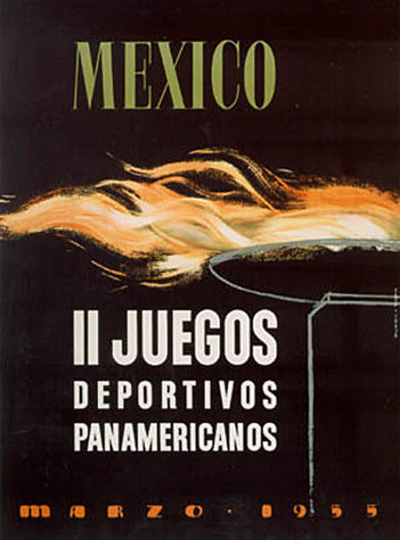
The 1955 Pan American Matches
by William T. Toney, Jr.
The 12-man rifle and pistol team selected by the U.S. Olympic Rifle and Pistol Shooting Committees to represent the United States in the II Pan American Games in Mexico City, March 12 - 26, 1955, assembled in San Antonio, Texas, on March 9 and flew to Mexico City on March 10. Several days later these men were joined by the skeet team selected by the National Skeet Shooting Association.
The rifle and pistol team had been named previously from the shooters who participated in the 36th World Shooting Championships in Caracas, Venezuela, in November 1954.
U.S. won most events entered
American dominated shooting events in the II Pan American Games by winning five out of the eight individual events and six out of the seven team events in which they entered.
The target range upon which the Pan American matches took place is located about 10½ kilometers north of downtown Mexico City. This shooting installation comprises, in one continuous plant, accommodations for both high power and small bore rifle at 50, 100, and 300 meters; pistol at 25 and 50 meters; rapid-fire pistol silhouettes; running-deer; and skeet. There are, in addition, provisions for the Mexican Defense course and plans for a trap range. The buildings and equipment are generally of good brick, concrete, and stone construction though lacking in some details of finishing and adjustment.
The principal range has 80 targets and firing points. All or any part of these may be used at ranges of 25, 50, 100, or 300 meters. From the same firing line, firing may be carried on with free-pistols, center-fire pistols; small bore rifles prone, small bore rifles three-position, and 300-meter free-rifle or military rifle. For practical reasons there naturally is no such combination of firing during matches. The firing points are 1½ meters apart from center to center. They are covered and are separated from each other by cement block partitions.
Immediately back of the firing line, and on a higher level, is a space for spectators. A spectator sitting in normal position in a chair has a clear view of the shooters immediately in front of him, and by looking over the roof of the firing line he may see all the targets. In addition to serving as a grandstand and cover for the firing line, the main range building includes storerooms for ammunition, arms, and equipment; statistical and scoring offices; an information office; and a restaurant.
Special purpose ranges
Along one side of the main range a passageway, protected on each side by a high stone wall, leads to the pits at the various ranges. Immediately to the right of the main range is the running deer range with a small stand for spectators back on the firing point. This was not in proper operation in time to hold running deer matches on schedule. On March 23, the day after the matches were officially closed, an attempt was being made to conduct the running deer matches.
Adjoining the running deer range is a silhouette range containing four batteries of five targets each, which may be used for the International rapid-fire match or the Mexican Defense course. A stand for spectators is well located back of the firing points and the silhouettes are automatically controlled and air-operated. During the matches there appeared to be difficulty in adjusting targets to the proper periods of exposure and keeping them in adjustment.
In front of the running deer and silhouette ranges, but separated from them by stone walls, is the single skeet field with a small stand for spectators and with its own storerooms.
The entire establishment is surrounded by and partitioned by stone walls.
Equipment used
Arms, equipment, and ammunition noted in these matches were generally very good. The competitors from Central and South America seemed to favor the Haemmerli free-rifle in 6.5mm caliber. Americans also used Winchesters, Finnish Lions, and Schultz & Larsens. In small bore there was a general assortment of American and European rifles. In the center-fire pistol match nothing other than Colt and Smith & Wesson revolvers was noticed in use. The firing line seemed to be completely equipped with Haemmerli, Schultz & Larsen, and Ullman free-pistols, with the Haemmerlis being greatly in the majority. In the rapid-fire pistol match there was a general assortment of American and European pistols. Among the five high men in this event Enrique Diaz Saenz Valiente, Forman, and Benner used the latest model Haemmerli-Walther rapid-fire pistols. McMillan and Mitchell used .22 short Hi-Standards.
On the skeet field there was a varied assortment of makes and models. Remington automatics, a Winchester Model 12, a Remington over-and-under, and a Browning over-and-under were among the top-place winners.
The U.S. team was allotted quarters at the University of Mexico, a magnificent establishment on the south side of Mexico City combining modernistic architecture with an ancient motif.
Matches well conducted
On the operational level the matches were generally well conducted. Camilo Kuri, a veteran competitive shooter from Tampico, was the chief range officer and directly in charge of the main range where the rifle and slow-fire pistol events were held. He was assisted there by a military detail of assistant range officers and scorers. Ernesto Montemayor of Monterrey, another veteran of Mexican Olympic pistol team, was in charge of the rapid-fire pistol silhouettes. Both these men were highly capable and carried out their duties in a commendable manner.
Francisco Atamoros of Mexico City was head of the scoring committee and chief statistical officer. He was so quiet and unobtrusive that some competitors did not know him at the end of the tournament, but he carried out his duties with smooth efficiency. Raul Ibarra of Mexico City served on various committees and was general coordinator and trouble shooter of the tournament. Gonzalo Aguilar, president of the Mexican Hunting, Shooting and Fishing Federation, which assumed the burden of conducting the matches under the organizing committee of the II Pan American Games, was a fine example of a smooth, efficient, capable executive in action.
Various countries were asked to supply representatives on the Appeals Jury, the Range and Pit Jury, and the Scoring Jury. Lieutenant Colonel Walsh of our team served on the Appeals Jury, I on the Range and Pit Jury, and several members of our team took turns in the scoring room.
Impressive opening ceremony
The Pan American Games were officially opened in a very complete and impressive ceremony at the University of Mexico stadium. The program followed very closely that with which the Olympic Games are usually opened. Among the speakers was the President of Mexico, who expressed pride in having these events in Mexico, lauded the spirit of Pan American Games, commented on the benefits of sports competitions, and welcomed the competitors to Mexico. A famous Mexican runner dashed into the stadium with the torch and lit the Olympic fire.
Representations from all the participating countries were present, drawn up in formations on the field and standing at attention while the flag of each nation was raised and its national anthem was played. The complete ceremony was long, and I was proud of the manner in which our marksmen bore up under it. Some highly trained hard hitting athletes collapsed, but at the end of the day the shooters were still on their feet.
Awards in the various shooting events consisted of attractive gold, silver, and bronze medals for first, second, and third place in the individual and team shooting events. The American team had carried the Argentine Cup to the matches, and the Congress of the Pan American Shooting Union, to which General Edson, Lieutenant Colonel Walsh, Dr. Swanson, and I were delegates, voted that in future Pan American Matches this trophy, the Visitors Cup, and another trophy believed to be in Argentine should be offered in the 300-meter free-rifle match, the small bore three-position match, the rapid-fire pistol match on silhouettes, respectively.
One attempt was made to present awards to the shooters in the University stadium where other athletic awards were made, but because of the late hours and several other minor difficulties, it was postponed. A complete presentation of shooting awards and a quiet, dignified closing ceremony was held at the target range the evening of March 22.
Mexicans were friendly
During the stay in Mexico City some of our people became aquainted for the first time with the Mexican people and the attractive features of Mexico. The people there are very expressive of their feelings. I heard them jeer Americans leaving a bullfight in the early stages with the question, "What's the matter? Don't you like anything but baseball?" I also had the pleasant experience of being picked up in an automobile, at a time of day when buses were overloaded and taxis unavailable, by complete strangers and delivered to the front door of our quarters simply because they wished to help us and make our stay there pleasant.
A comparison of the scores fired in the principal events of the 36th World Shooting Championships at Caracas, Venezuela, in November 1954 and the Pan American Matches indicates that winning scores in both team and individual rifle events at Mexico City were considerably lower than at Caracas in the same events. United States' scores were slightly higher at Mexico City in the three-position free-rifle and small bore rifle events and slightly lower in the prone English Match than at Caracas.
Free-pistol scores were slightly lower at Mexico City than Caracas. The Russians won at Caracas with 2722. The American team shot 2706 at Caracas and 2671 in Mexico City. The center-fire pistol team scores were slightly lower in Mexico City than the Russians' winning score at Caracas; the American team score was 2311 at Mexico City compared to 2316 at Caracas. However, Benner's 588 beat the 586 with which Ullman won the individual center-fire pistol championships at Caracas.
Rapid-fire pistol scores high
The rapid-fire pistol score fired by the American team at Mexico City tops that with which the Russians won the world championships at Caracas in 1954 by 11 points (2328-2317) and is a 36-point improvement over our own Caracas score. Two Americans and the Argentine winner all equaled or surpassed the individual score of 284 fired by Kalinichenko of Russia at Caracas. It is doubtful, however, if these scores can be recognized as records because of the mechanical difficulties in adjusting the timing of the targets.
Since these matches two questions have occurred to me. How can we improve the American standing in International shooting? And, of what value is it to us?
Complete answers would be lengthy. One thing that would improve our proficiency over International course of fire is more frequent participation in those courses in our own matches and a stronger competitive spirit among all shooters. By that I mean a stronger will to place nearer the top with a better score without excuses or special favors.
Many shooters regard International courses of fire as impractical. The slow-fire events are no more impractical than our own, and they are more conclusive tests of marksmanship. The rapid-fire pistol silhouette course, the center-fire pistol course, and the running deer match are more practical for combat and field shooting than any of the courses regularly fired in our registered matches.
American shooters are still relatively new to some of the courses fired in International rifle and pistol competition. They are gaining experience steadily in domestic competition by participating in the matches over courses of fire which parallel those fired in International contests. The experience gained by competing in the 36th World Shooting Championships at Caracas, Venezuela, in November 1954 and the II Pan American Games at Mexico City in March 1955 provides a nucleus of competitors with a background of International match shooting. It is hoped that these will benefit the United States in future International competitions.
American Rifleman, Vol. 103, No. 5, May 1955
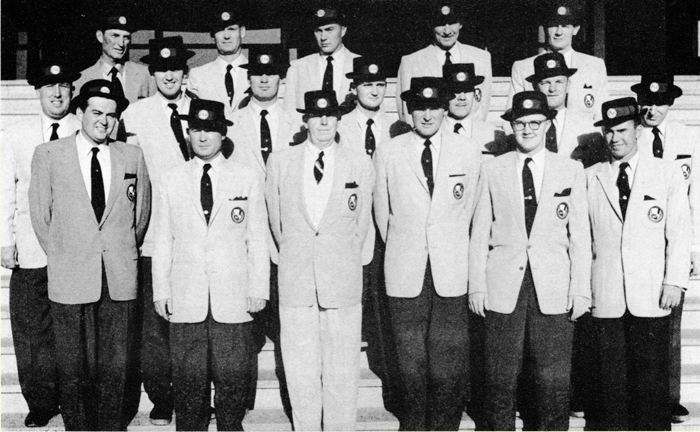
U.S. Shooting Team
Rifle Members
Arthur C. Jackson; A2/c Allan L. Luke, USAF; Robert Sandager, Emmet O. Swanson, August Westergaard, Verle Wright and James M. Smith (Alternate)
Pistol Members
M/Sgt. Huelet L. Benner, USA; Capt. John F. Dodds, USA; Capt. John M. Jagoda, USMC
John C. Forman (Alternate); 2nd Lieut. William W. McMillan, Jr., USMC
and Capt. Thomas R. Mitchell, USMC
Skeet Members
Henry L. Adler, Frederick F. Alford, Sr., Chesley J. Crites, George W. Glass, Sr., Igor Pezas
and CPO Kenneth L. Pendergras, USN
Team Management & Support
Merritt A. Edson (NRA Executive Director), Walter R. Walsh (Team Captain)
and
William T. Toney, Jr. (Team Adjutant-Coach)
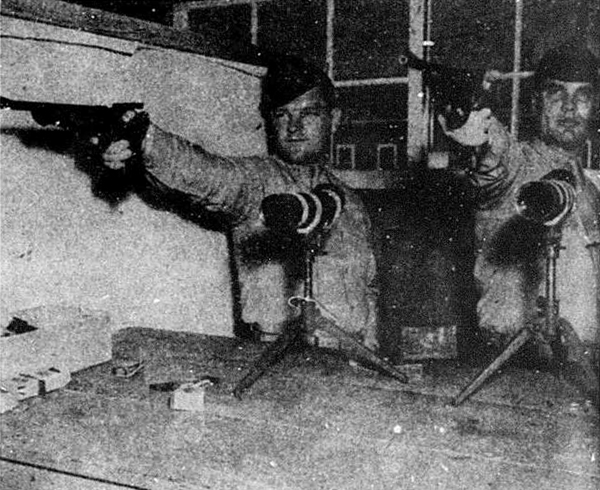
Marine Capt. John M. Jagoda, left and 1st Lt. William W. McMillan, practice on the pistol range here in preparation for the Pan-American Pistol Matches in Mexico City.
PI Pistol Team Groups Shooters For PA Matches
The Post Pistol Team from the Marine Corps Recruit Depot here, were divided into two groups in order that the Marine Corps may be represented in the Pan-American Matches in Mexico City and three matches in Florida.
Captain John M. Jagoda and 1st Lt. William W. McMillan of Parris Island will meet Lt. Col. Walter R. Walsh, Camp Lejeune, N. C. and Capt. Thomas R. Mitchell of the supply depot, Albany, Ga., to represent the Marines at Mexico City.
The Pan-American Matches will have about 26 countries represented and will begin the latter part of this month.
Lt. McMillan who recently returned from Venezuela, here he won an individual international match was disappointed that the Russian team would not be at Mexico City.
The Russians won some matches as a team in Venezuela and Lt. McMillan was anxious to match our Marine foursome against the Soviets.
A five-man team, firing in the Fla. competition, will oppose other service teams and police teams from the nations larger cities.
Included in the group are 1st Lt. Norman E. Fournier; CWO Leonard E. Oderman; MSgt. Ralph H. Hagan, Floyd D. Hafer and TSgt. Walter L. Devine.
Their first match will be held this Saturday and Sunday at Raiford, where they will enter the Fla. State Prison Matches.
Next stop will be Tampa and the four-day, Mid-Winter Matches.
The BOOT Parris Island Weekly, Friday, March 11, 1955
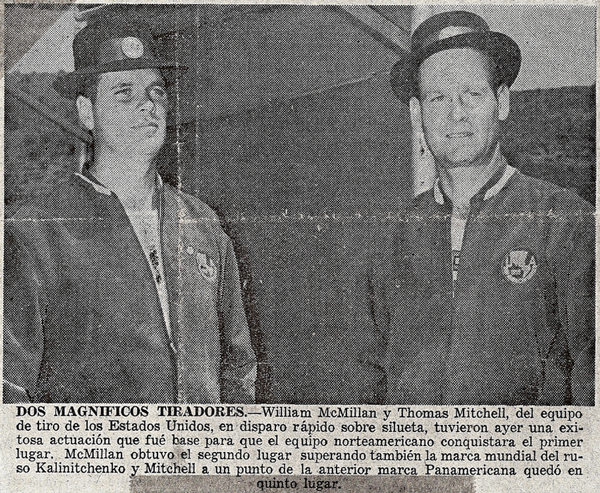
"TWO GREAT MARKSMAN. - William McMillan and Thomas Mitchell, of the United States shooting team, in rapid-fire silhouette, had a sucessful performance yesterday that was the basis for the U.S. team winning first place. McMillan obtained the second place also surpassing the world record of the Russian Kalinitchenko and Mitchell to a point of the previous Pan American mark remained in fifth place."
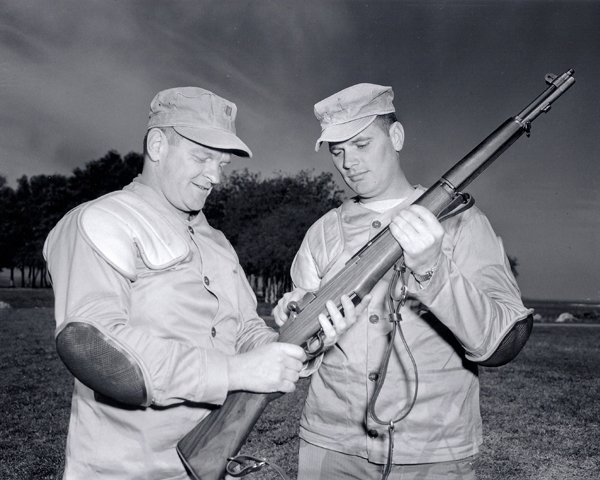
PARRIS ISLAND SHOOTERS IN PAN AMERICAN MATCHES — Captain John M. Jagoda, left, and First Lieutenant William W. McMillan.
MC Storms Matches
Capt. John M. Jagoda and 1st Lt. William W. McMillan of Parris Island were among the Marine Corps representatives on the United States pistol team which captured first place in every team event at the Pan-American Games last month.
Sixteen countries, 10 of which had full teams, were represented in the pistol competition.
McMillan aided the United States cause by placing second in both the .38 Individual shooting and the .22 rapid fire.
Jagoda shot on both the free pistol slow fire team and the .38 team.
Their firing enabled the United States Rifle and Pistol team to accumulate more points than any other U.S. team in the Mexico Classic.
The United States won all but one of its rifle matches.
McMillan who represented the United States in the 1952 Olympics, called the Pan-American event a "miniture olympics."
His shooting at Mexico City added laurels to a star-studded pistol and rifle career. He began in 1949 [1952] by competiting in the International Matches at Norway.
Last December he won the Host Match during firing in international matches at Venezuela.
Distinguished with both the rifle and pistol, McMillan competed in the Marine Corps matches in 1949 '50 and '54.
The BOOT Parris Island Weekly, Friday, April 1, 1955
| Place | Name | Country | Total Points |
|---|---|---|---|
| 1st | Enrique Saenz Valiente | Argentina | 589 |
| 2nd | William W. McMillan | USA | 586 |
| 3rd | John C. Forman | USA | 584 |
| 4th | Huelet L. Benner | USA | 581 |
| 5th | Thomas Mitchel | USA | 577 |
| 6th | Mario de Armas | Cuba | 576 |
Source: 1956 US Olympic Book
| Place | Country | Team Members | Total Points |
|---|---|---|---|
| 1st | USA | William W. McMillan: 586 John C. Forman: 584 Huelet L. Benner: 581 Thomas Mitchell: 577 |
2328 |
| 2nd | Argentina | Enrique S. Valiente: 589 Oscar Cervo: 572 Dionisio Fernandez: 572 Enrique Schack: 559 |
2292 |
| 3rd | Mexico | Rene Arredondo: 575 Alfonso Castaneda: 567 Luis Jimenez: 567 Carlos Rodriguez: 564 |
2273 |
| 4th | Venezuela | Hernan Barreto: 576 Carlos Monteverde: 571 Alfredo Sabater: 552 Jose H. Paredes: 549 |
2248 |
| 5th | Brazil | Pedro Simao: 574 Adhary DaCosta: 565 Silvino Fernandez: 544 Rubens Teixeira: 540 |
2223 |
| 6th | San Salvador | Ricardo Lopez: 548 Tito Castillo: 537 Jose A. Castillo: 534 Jesus Rodriguez: 524 |
2143 |
Source: 1956 US Olympic Book
| Place | Name | Country | Total Points |
|---|---|---|---|
| 1st | Huelet L. Benner | USA | 588 |
| 2nd | William W. McMillan | USA | 577 |
| 3rd | John C. Forman | USA | 576 |
| 4th | Miguel Emanuelli | Pureto Rico | 571 |
| 5th | John Jagoda | USA | 570 |
| 6th | Jose Angel Gomez | Guatemala | 569 |
Source: 1956 US Olympic Book
| Place | Country | Team Members | Total Points |
|---|---|---|---|
| 1st | USA | Huelet L. Benner: 588 William W. McMillan: 577 John C. Forman: 576 John M. Jagoda: 570 |
2311 |
| 2nd | Puerto Rico | Miguel Emanuelli: 571 Alberto Guerrero: 566 Ernesto Rivera: 564 Vivano Ramierz: 551 |
2252 |
| 3rd | Venezuela | Carol Monteverde: 562 Carlos Marrero: 562 Humberto Paredes: 561 Jose I. Bernal: 539 |
2234 |
| 4th | Mexico | Manuel Larranaga: 568 Carlos Rodriguez: 563 Enrique Soto: 556 Luis Jimenez: 532 |
2219 |
| 5th | Guatemala | Jose A. Gomez: 569 Francisco Sandoval: 562 Gabriel Zamayoa: 548 Rafael Coronado: 536 |
2215 |
| 6th | San Salvador | Tito Castillo: 567 Carlos Rozeville: 543 Jesus Rodriguez: 541 Ricardo Lopez: 530 |
2181 |
| 7th | Colombia | - | 1890 |
Source: 1956 US Olympic Book
| Place | Name | Country | Total Points |
|---|---|---|---|
| 1st | Huelet L. Benner | USA | 549 |
| 2nd | John Dodds | USA | 544 |
| 3rd | Pedro Aviles Franco | Mexico | 542 |
| 4th | Thomas Mitchell | USA | 539 |
| 5th | O. Bidegain | Argentina | 537 |
| 6th | R. Lopes | San Salvador | 535 |
| 12th | John M. Jagoda | USA | 529 |
| 32nd | John C. Forman | USA | 510 |
Source: 1956 US Olympic Book
| Place | Country | Team Members | Total Points |
|---|---|---|---|
| 1st | USA | Huelet L. Benner: 549 John Dodds: 544 Thomas Mitchell: 539 John M. Jagoda: 529 John C. Forman: 510 |
2671 |
| 2nd | Argentina | - | 2619 |
| 3rd | Mexico | - | 2618 |
| 4th | Brazil | - | 2598 |
| 5th | San Salvador | - | 2587 |
| 6th | Colombia | - | 2541 |
| 7th | Venezuela | - | 2535 |
Source: 1956 US Olympic Book














